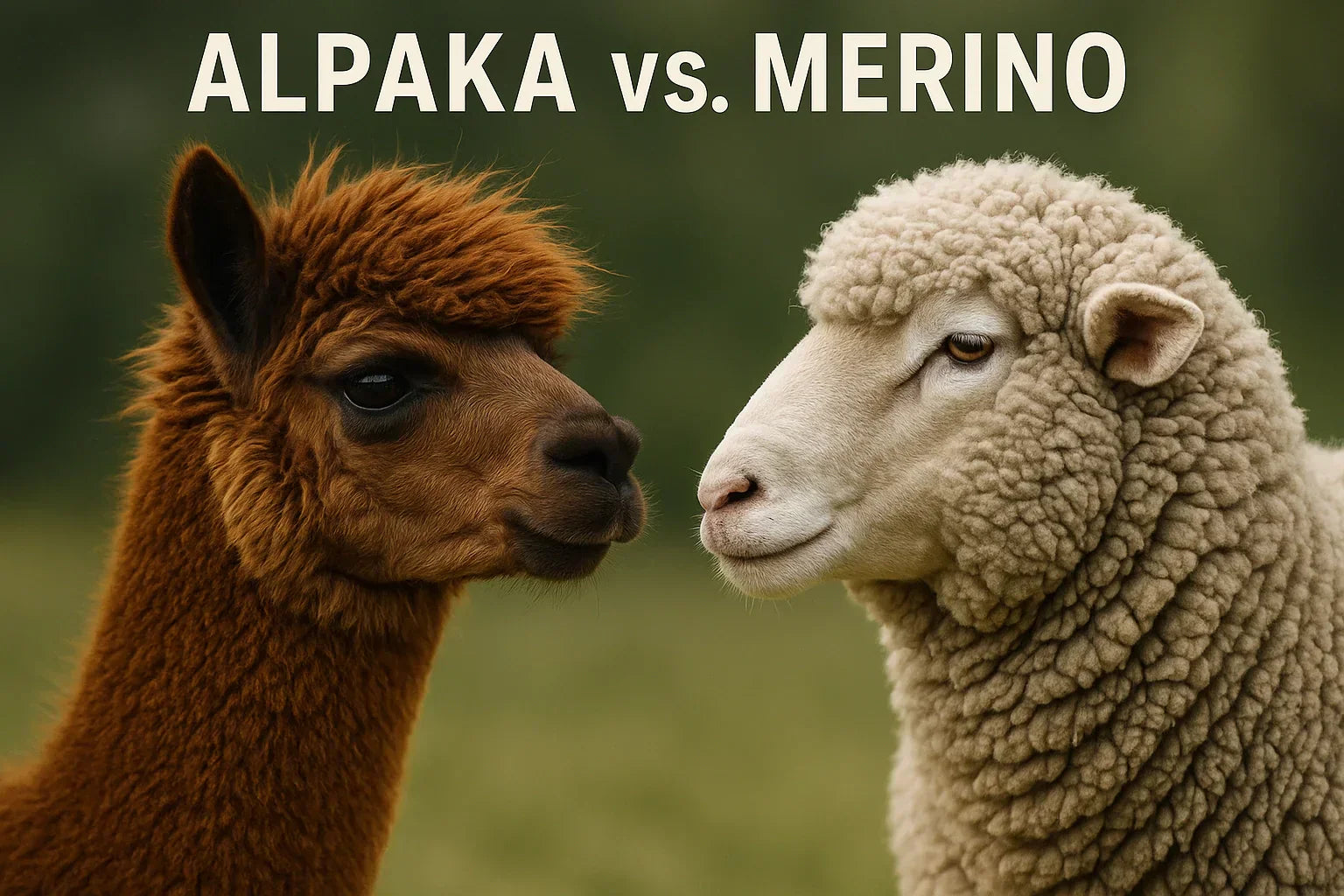ALPACA VS. MERINO WOOL
·

·
-
In this post, we'll take a detailed look at two natural fibers – Merino wool and Alpaca – which are often confused due to their similar properties. Because it's very difficult to distinguish these two fibers with the naked eye, we'll explore their properties, revealing what's hidden inside.
Alpaca and merino are true players in the world of yarn. They are undoubtedly among the most luxurious yarns that have taken the world by storm. They are renowned in the textile and apparel industries for their exceptional softness and delicate texture. While merino wool has only recently become a high-end commodity, alpaca fiber has reigned supreme in the world of luxury clothing for years, embodying old-school elegance, soft to the touch, softer and stronger than cashmere, and significantly lighter than sheep's wool.
Common features of alpaca fiber and merino wool
Before we delve into the differences between these two fibers, let's look at the similarities. The first common feature is, of course, their natural origin and their completely biodegradable nature. Another key feature that connects alpaca and merino fibers is their exceptional breathability, UV resistance, and thermoregulation, thanks to which products made from both fibers will keep us cool on hot days and pleasantly warm on cold days. Another equally important common feature is their odorlessness and resistance to unpleasant odors, which often accumulate when wearing synthetic clothing during intense or prolonged exertion.
Alpaca and merino fibers share several similar properties, leading us to conclude that they are equally good. Nothing could be further from the truth. So what are the differences between them? Below, we'll discuss the most important ones: softness, hypoallergenic properties, durability, warmth, water absorption, and dirt resistance.
Softness, hypoallergenic and durability - Merino fiber and Alpaca fiber
The photo below shows alpaca and merino fibers examined under a microscope. Only under such high magnification can we see the differences in their external structure. Both fibers have visible scales, but alpaca's scales are much smaller than merino wool, which in turn makes alpaca more pleasant to the touch. The smoother the fiber, the more comfortable it feels when in contact with human skin, which is why merino fibers are more itchy and irritating. This is especially important for people prone to allergic reactions. While on the subject of allergies, it's worth emphasizing that alpaca fiber is naturally free of lanolin—an animal wax also responsible for allergic reactions. Unfortunately, lanolin is found in sheep wool, including merino, so it's not recommended for people with these issues. Currently, various chemical procedures are being used to remove lanolin from merino wool, making it safe for allergy sufferers. However, this has an impact on both the environment and the natural values of the fibre itself.

Analyses conducted so far have confirmed that alpaca fibers have a higher tensile strength than merino, meaning they can withstand greater pressure or stress before breaking. Studies indicate that alpaca fiber has a tensile strength of up to 50 N/ktex, allowing for the creation of clothing resistant to heavy wear. Merino fiber, on the other hand, can withstand pressure up to 30-40 N/ktex.
Alpaca or Merino - which keeps you warmer better?
We previously mentioned that both alpaca and merino wool have excellent moisture-wicking properties, effectively wicking moisture away from the skin during sweating. Both effectively absorb moisture and transport it to the outside of the garment. This fundamental characteristic prevents odor and increases wearer comfort. But what about warmth retention? Alpaca fibers have a unique physical structure characterized by air pockets. These voids trap air, which in turn enhance the fiber's thermal properties and provide the wearer with a better sense of warmth. This semi-hollow structure makes alpaca fibers incredibly lightweight, offering greater warmth-to-weight than merino wool with a similar fiber size. Primarily bred in the cool climate of the Andes, alpaca is naturally adapted to survive freezing temperatures.
Water absorption and dirt resistance of Alpaca and Marino fibers
Alpaca fibers are considered exceptionally waterproof while also offering high breathability. This is because they absorb only about 10% of their weight in water, compared to about 30% for merino wool. This means alpaca dries faster and insulates better than merino when wet. Furthermore, the lack of lanolin in alpaca fiber makes it more resistant to dirt, and if it does become dirty, cleaning is much easier than merino wool.
Alpaca vs. Merino - which fiber is better?
The table below highlights the key similarities and differences between alpaca and merino fibers . Without a doubt, alpaca fiber surpasses merino in many respects, making it a more luxurious and desirable fiber. This exquisite fiber is known for its unique molecular composition, combining the benefits of merino wool and cashmere, creating a delicate texture that is sought after for its softness, excellent warmth, moisture-wicking breathability, and naturally hypoallergenic composition. Natural alpaca fiber offers an ultra-luxurious feel and a subtle texture that's hard to beat.
Additionally, alpaca is our eco-friend. This ultra-fine fiber is never processed with harsh chemicals or synthetic processes, which merino wool requires to be soft and comfortable. Merino wool often needs to be blended with other synthetic fibers, such as nylon, to both enhance its luxury and increase the risk of microplastic contamination in the environment.
ALPACA VS. MERINO - COMPARISON
| CHARACTERISTIC | ALPACA | MERINO |
| Warm | 5x warmer | Warm |
| Softness | Very soft | It can scratch |
| Libra | The lightest | Heavier |
| Resilience | The strongest | Strong |
| Fiber structure | Empty core | Semi-hollow core |
| Water retention | 10% absorption | Up to 50% absorption |
| Hypoallergenic | Yes | NO |
| Ecological | Yes | NO |
In comparing Merino and Alpaca fibers, we focused primarily on their properties and what's inside them. Now, however, we'll take a closer look at alpaca yarn and discover its unique qualities.
What is alpaca wool?
Alpaca produces wool of extraordinary fineness and softness. For centuries, it has been prized by the indigenous peoples of South America, particularly those of Peru. Alpaca wool provides warmth, is lightweight, soft, and possesses many properties that make it increasingly popular throughout the fashion world. Alpaca yarn, especially that labeled "baby alpaca," is one of the most luxurious fibers available.
100% alpaca: what does that mean?
When we talk about 100% alpaca, we mean pure, unblended alpaca yarn , free from any synthetic additives. " Baby alpaca " yarn refers to the finest fibers obtained from alpacas, which are particularly soft, delicate, and pleasant to the touch. This fiber is ideal for making products that come into direct contact with the skin, such as alpaca hats, headbands, gloves, and scarves .
Differences between Suri and Huacaya alpaca wool
There are two main types of alpacas: Suri and Huacaya, which produce different types of fiber.
Suri Alpaca Fiber
Suri alpaca wool is known for its long, silky strands that give it an extraordinary shine. It is perfect for making luxury items like coats, jackets, and sweaters.
Huacaya alpaca fiber
Huacaya alpaca wool, on the other hand, is fluffier and denser, giving it more pronounced insulating properties than suri. Huacaya alpaca fiber is also more resilient and elastic. Furthermore, it is easier to work with and more versatile.
Uses of alpaca wool
Alpaca clothing, such as alpaca coats and sweaters, is not only stylish but also functional. Alpaca is suitable for weaving exceptionally warm, yet lightweight garments. Alpaca yarn is also popular for making scarves and hats . and other accessories. Furthermore, alpaca wool is often used as filling for bedding, providing exceptional thermal comfort and breathability. Alpaca wool bedding are valued for their ability to thermoregulate, which makes them ideal for both cold and warmer nights.
Hypoallergenic wool: products for allergy sufferers
Alpaca fiber is valued for its natural hypoallergenic properties. This makes alpaca clothing, especially 100% baby alpaca , an excellent choice for those with sensitive skin. Unlike other fibers, hypoallergenic alpaca wool doesn't cause irritation.
Caring for alpaca and merino wool clothing
Caring for alpaca clothing differs slightly from caring for merino wool products. Washing alpaca clothing requires a mild detergent and hand washing in cool water. Avoid twisting and wringing, which can damage the delicate fibers. Merino clothing, on the other hand, often requires extra care due to the blend of wool and other materials.
In summary, both alpaca and merino have much to offer in the world of textiles. However, alpaca clothing is significantly higher quality, which is why it is gaining popularity.



